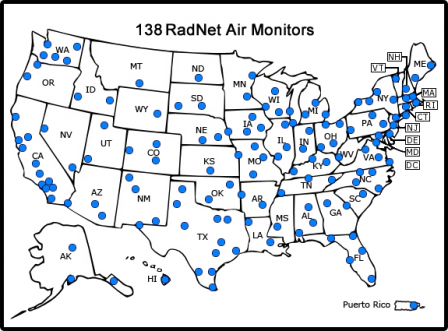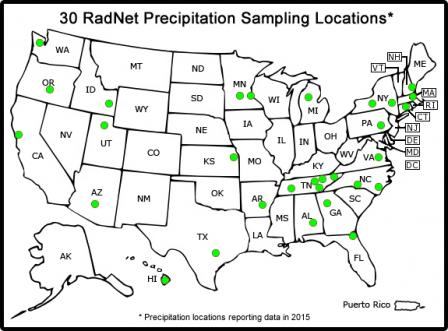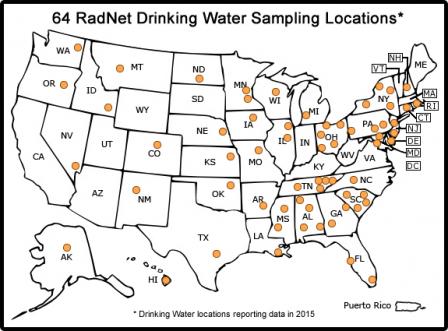Learn About RadNet
The nationwide RadNet system monitors the nation's air, precipitation and drinking water to track radiation in the environment. Over time, RadNet sample testing and monitoring results show the fluctuations in normal background levels of environmental radiation. The RadNet system will also detect higher than normal radiation levels during a radiological incident.
RadNet has tracked radiation from both atmospheric nuclear weapons tests and nuclear reactor accidents at Chernobyl (Ukraine) and Fukushima (Japan). During a radiological incident, public officials use RadNet data to help make science-based decisions about protecting the public. Scientists use RadNet air monitoring data to help estimate the potential radiation dose to humans. They use both air and precipitation data to determine if contaminated rain or snow will wash radionuclides into the soil or water. Learn how RadNet was used during and after Chernobyl, Fukushima and other radiological incidents.
RadNet has more than 135 stationary air monitors located across all 50 states. RadNet also has 40 deployable![]() deployableIn the RadNet system, portable monitors that can be sent (deployed) quickly to a location where they are needed. air monitors that can be sent anywhere in the United States if needed. RadNet stationary monitors run 24 hours a day, 7 days a week, and send near-real-time measurements of gamma radiation to EPA’s National Analytical Radiation Environmental Laboratory (NAREL). Computers continuously review these data. If there is a meaningful increase in radiation levels, laboratory staff are alerted and then investigate the cause.
deployableIn the RadNet system, portable monitors that can be sent (deployed) quickly to a location where they are needed. air monitors that can be sent anywhere in the United States if needed. RadNet stationary monitors run 24 hours a day, 7 days a week, and send near-real-time measurements of gamma radiation to EPA’s National Analytical Radiation Environmental Laboratory (NAREL). Computers continuously review these data. If there is a meaningful increase in radiation levels, laboratory staff are alerted and then investigate the cause.
Addition of Exposure Rate Measurement Capabilities
The RadNet system is adding hourly exposure rate data to its existing capabilities. Exposure rate measurements indicate the level of radiation present in the vicinity of the monitor. Hourly exposure rate measurements are widely used internationally, and this addition will make it easier to compare RadNet monitoring results with data from other monitoring stations across the world. The addition of exposure rate data is an upgrade to the current system capabilities. The RadNet system will continue to report gross gamma count rates in near-real-time and laboratory analyses will remain the same.
This upgrade will be installed in phases, to eventually include all RadNet’s air monitoring stations. Exposure rate measurement capability will be added when a station’s gamma-ray detector is serviced as part of regular system maintenance. The 10 most populated U.S. cities and Washington, D.C received exposure rate measurement capability by the end of 2016. EPA is striving to add exposure rate measurement to at least one station in each state as soon as reasonably possible. The addition of exposure rate detectors to all RadNet stations may take several years.
List of Upgraded RadNet Stations
The following RadNet stationary monitors have been upgraded and are reporting hourly exposure rate.
Alabama
Alaska
Arizona
California
District of Columbia
Florida
Illinois
Louisiana
Massachusetts
Missouri
Nebraska
New York
PA
Texas
Vermont
Washington
RadNet sample analyses on precipitation, drinking water and air filters are conducted following a routine schedule, unless analysis is accelerated after an emergency event. Learn more about RadNet sampling and analyses schedules.
- Air Filters
Filters on RadNet air monitors capture particles from the air (airborne particulates). Monitor operators collect the filters and send them to EPA’s National Analytical Radiation Environmental Laboratory (NAREL) for testing. Staff use these test results to calculate the concentration of radionuclides on the filters and find trends in airborne radiation. Detailed laboratory analysis of air filters detects trace amounts of radioactive material that the sensitive near-real-time air monitors can't detect in real-time. Laboratory analysis identifies the radioactive material and the average concentration in picocuries per cubic meter (pCi/m3) on each air filter.
RadNet stationary monitors collect air particulates continuously during routine conditions and during radiological incidents. EPA can also set up portable (deployable) monitors during radiological incidents.
RadNet stationary and deployable air monitors collect air particulate samples in two ways:
- Filter Sampling: RadNet stationary and deployable monitors pass air through a filter which traps particulates. Filters are sent to NAREL for a sensitive screening analysis and, if needed, additional laboratory analyses that identify the radionuclide(s) on the filter.
- Air Cartridge Sampling: RadNet deployable monitors may also pass air through a cartridge that contains charcoal. The cartridges collect radioactive gases, similar to how a home charcoal air filter traps cooking odors. The cartridges are sent to NAREL for a sensitive laboratory analysis that can detect gaseous radioactive material in the sample. RadNet stationary air monitors cannot use charcoal cartridges.
Monitor operators collect stationary monitor air filters and send them to NAREL for analysis. A gross (total) beta analysis is performed on each air filter, followed by a gamma scan if the beta activity is greater than 1 pCi/m3. Each year, a composite sample of the air filters for each monitor is analyzed for gamma emitting radionuclides. Isotopic plutonium (Pu-238, Pu-239/Pu-240) and uranium (U-234, U-235, and U-238) analyses are performed on composite samples from one-fourth of the stations on a four-year rotating schedule. We cannot distinguish between Pu-239 and Pu-240, so we write it as Pu-239/240.
View RadNet air filter results by monitoring station, or search for results on the Envirofacts website.
- Precipitation
EPA scientists routinely test precipitation samples from 28 sites in the U.S. to find trends in radionuclide concentration. The stations submit precipitation samples to NAREL following rainfall, snow or sleet events. Under normal conditions, scientists composite the samples and analyze them monthly. The composite sample is analyzed for gamma-emitting nuclides. Results are reported in picocuries per liter (pCi/L).
- Drinking Water
EPA's RadNet program obtains quarterly drinking water samples from 58 sites across the country for laboratory analysis. Every sample is analyzed for tritium (H-3) quarterly. One sample from each station is analyzed for iodine-131 (I-131) once a year.
An annual composite sample from each monitoring station is analyzed for gross alpha and beta radiation. Any sample with elevated gross alpha radiation (2 pCi/L) will be analyzed for radium-226 (Ra-226), plutonium (Pu-238, Pu-239 Pu-240), and uranium (U-234, U-235, and U-238). If the radium-226 result is between 3 and 5 pCi/L, then the sample is analyzed for radium-228 (Ra-228). All of the annual composite samples are also analyzed for gamma-emitting radionuclides. Twenty-five percent (25%) of the annual composite samples from each monitoring station are analyzed for strontium-90 (Sr-90).



